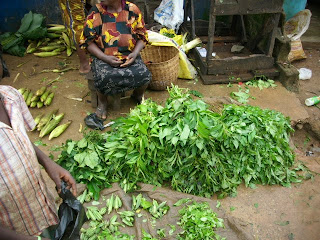
Wednesday, 29 September 2010
Article 60: "EFO YANRIN"-Wild Lettuce

Monday, 27 September 2010
Article 59: "EFINRIN" (The Scent Leaf)

By S.Olanrewaju Disu
Article 58: The "Ebolo" Vegetable


Article 57: The "Afang" Vegetable

Wednesday, 15 September 2010
Article 56: BITTER LEAF


Its scientific name is "Vernonia amygdalina, Family Compositae"Its vernacular name is "ewuro"- meaning something bitter. During the rainy season, the "bitter leaf" plant grows so much foilage. There are several species-some large, leafy and deep green leaves, while some have comparatively smaller leaves. The leaves are very bitter. The bitterness is usually removed by boiling before the leaves are cooked as soups or added to soups made with other vegetables or eaten as spinach.
Generally, the Igbo speaking members of the populace use the bitter leaf mostly as a vegetable while the Yoruba 's use it more as medicine.
The leaves are also taken as an appetizer and digestive tonic. Furthermore, they are held to be anti-scorbutic. Bitter leaves are widely used for fevers and leaf decoction is usually taken as laxative among our local people. Traditionally, some women, immediately after childbirth may take a decoction of the leaves to affect their milk so as to act as a prophylactic against worms in the baby. Also traditionally, bitter leaves are rubbed on the brests for weaning infants.
The wood of the bitter leaf plant as well as the twigs are used as traditional chewing sticks and a tooth cleaner for some highly traditional members of the populace in Lagos State.
Because of the diverse usefulness of the bitter leaf, the plant is commonly grown as a hedge or compound fence. At times in homes with gardens and bitter leaf plants, bitter leaf seeds are used as aphrodisiac and the powdered seeds used as worm expeller.
Photo's
(A) The "bitter leaf" plant growing in a garden in Lagos Area
(B) A bunch of bitter leaf vegetables on sale at the "Oyingbo Market"
(C) Bitter leaf Vegetables at close range
Article 55: "UTAZI"
This vegetable is very popular among the Igbo speaking residents of the state, is a climber from a tuberous root and the leaves serve as a vegetable. Its stems are soft and pliable.
The "Utazi" vegetable is botanically known as "Gongronema latifolium, Family Aselepiadaceae"
The Yoruba speaking populace of the state call it "arokeke". During the rainy season, it is available in abundance and cheaply too.
This vegetable is eaten cooked in soups either by itself or in conjuction with others e.g. "okro" or "ugu"- the fulted pumlin vegetable. Dried stockfish, crayfish and other condiments are normally added to enhance the palatability of soups made from "utazi" vegetables.
Illustrative photos : (A) The "utazi" vegetable on sale at the "Oyingbo" Market
Article 54: "EWEDU" - The Long Fruited Vegetable


Article 53: "AMUNUTUTU" OR EUROPEAN HERB, INDIAN SPINACH, OR "MALABAR NIGHT SHADE"


By S. O. Olanrewaju Disu

